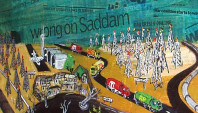Strong campaign sees arms trade-embedded Kanders' resign from Whitney Museum in NYC
Taken from https://hyperallergic.com/511052/warren-kanders-resigns/
'After months of protest, an emerging biennial boycott, and an accusation of war crimes, Warren Kanders has resigned from his position as vice chairman of the Whitney Museum of American Art’s board of trustees.
“The targeted campaign of attacks against me and my company that has been waged these past several months has threatened to undermine the important work of the Whitney,” said Kanders in his resignation letter to the board, according to the New York Times, which first reported his stepping down. “I joined this board to help the museum prosper. I do not wish to play a role, however inadvertent, in its demise.”
Last year, Hyperallergic broke the story about Kanders, which tied the Whitney to weapons manufacturing. The now-former vice chairman owns Safariland, a company that produces military supplies like tear gas, which has been hurled at migrants at the United-States–Mexico border and elsewhere during protests. He also partially owns Sierra Bullets, which the collective Forensic Architecture alleges may be involved in lethal war crimes by the Israeli army against Palestinian civilians at the border in Gaza.
As news of the artist boycott broke last Friday, the uprising against Kanders threatened to spill into mainstream media with concentrated attention by national outlets like NPR and the New York Times. For months prior, a grassroots coalition led by the activist group Decolonize This Place staged nine weeks of protests at the museum and other demonstrations, keeping the Kanders issue at the fore of art world conversation.
Kanders joined the Whitney board in 2006 and has been on the executive committee for five years, donating more than $10 million alongside his wife, Allison, who has simultaneously resigned from the museum’s painting and sculpture committee. There is a stairway at the museum named after the couple who are also avid collectors of art from blue-chip names like Jeff Koons, Christopher Wool, and Ed Ruscha.
Protests began in November when more than 100 staff members signed a letter demanding the museum respond to the Hyperallergic report linking Kanders to the US-Mexico border crisis. Museum director Adam Weinberg responded to the controversy, stating in part that the Whitney “cannot right all the ills of an unjust world, nor is that its role” and that the institution must stay “a safe place for unsafe ideas.”
Kanders responded with his own letter to staff in December. “I am not the problem,” he wrote. “We also manufacture the non-lethal products that started this discussion, including what is commonly known as tear gas. Non-lethal products were created as an alternative to lethal solutions.” At the time, the former vice chair’s connection to Sierra Bullets had not been reported by media outlets.
That month, Michael Rakowitz became the only artist to preemptively pull out of the 2019 Whitney Biennial. Four months later, a group of critics, scholars, and artists called for Kanders’s removal — including many artists presenting work in the biennial.
Last week, four artists (Korakrit Arunanondchai, Meriem Bennani, Nicole Eisenman, and Nicholas Galanin) withdrew from the exhibition in a letter published by Artforum, asking the Whitney to remove their work from the biennial. Four others joined the emerging boycott, creating a tipping point for the institution that threatened to overshadow the work of curators Rujeko Hockley, Jane Panetta, and the more than 60 remaining artists.
Until recently, the controversy had done little to shake Kanders’s position at the museum. He was unanimously reappointed vice chair last month, according to the New York Times. But some on the board debated his position with the museum. Some thought he should have quit for the good of the museum while others believed that stepping down would embolden protesters to call for more resignations of board members with ties to other unsavory business investments.
“The politicized and oftentimes toxic environment in which we find ourselves across all spheres of public discourse, including the art community, puts the work of this board in great jeopardy,” wrote Kanders in his resignation letter.
The letter makes it unclear whether or not Kanders is leaving the Whitney Museum on the best of terms. He writes: “I hope you assume the responsibility that your position bestows upon you and find the leadership to maintain the integrity of this museum.”
The Whitney Museum has not responded to Hyperallergic’s immediate request for comment.'



